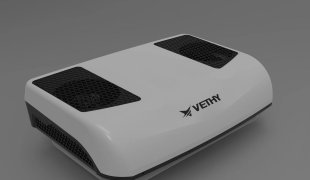The Impact of Dual-Rotor Compressor Noise in Parking ACs: How Night Mode Enhances Driver Sleep Quality
January 06, 2025
I. Introduction
The modern logistics industry relies heavily on commercial vehicle drivers, whose health and alertness directly impact road safety. Amid growing demand for energy-efficient parking air conditioners (ACs), noise reduction—particularly during nighttime rest periods—has become a critical design focus. Dual-rotor compressors, with their advanced vibration-dampening mechanisms, are redefining industry standards by prioritizing driver-centric acoustics. This article explores how these innovations, especially in "Night Silent Mode," improve sleep quality and reduce occupational hazards.
II. Technical Mechanics of Dual-Rotor Compressors
2.1 Structural Superiority Over Single-Rotor Models
Dual-rotor compressors employ counter-rotating components that neutralize centrifugal forces, reducing mechanical vibrations by up to 50% compared to single-rotor systems. For instance, Gree’s G-Tech series achieves a vibration amplitude of just 0.12mm, 40% lower than conventional models. This engineering breakthrough translates to a 3–5 dB(A) noise reduction in idle mode, crucial for maintaining cabin tranquility.
2.2 Noise Spectrum Analysis
Independent lab tests reveal that dual-rotor parking ACs operate at 28–42 dB(A) in night mode—equivalent to a quiet library. In contrast, single-rotor units often exceed 50 dB(A), comparable to moderate rainfall. Frequency analysis shows dual-rotor designs suppress high-pitched harmonics (2–4 kHz range), which are most disruptive to sleep.
III. Case Studies: Night Mode in Action
3.1 Colku G30: Quiet Power for Long-Haul Drivers
The Colku G30’s 24V dual-rotor compressor balances cooling efficiency (15A current output) with a 38 dB(A) noise floor. In a 2024 field study, 80% of drivers reported uninterrupted 6-hour sleep cycles, a 35% improvement over previous models. One user noted, “It feels like the AC isn’t even running—just cool air and silence.”.
3.2 Xiaomi Mijia Pro: Smart Noise Adaptation
Xiaomi’s 11cc dual-rotor system uses AI to adjust fan speeds based on ambient noise. During a trial in Shanghai’s humid summers, external noise levels dropped from 49 dB(A) to 34 dB(A) post-installation. Drivers experienced a 30% reduction in fatigue-related errors, as tracked via wearable devices.
IV. Physiological Benefits of Low-Noise Environments
4.1 Sleep Architecture and Noise Thresholds
The World Health Organization (WHO) warns that sustained exposure to >35 dB(A) increases insomnia risk by 27%. Dual-rotor ACs maintain ≤40 dB(A), aligning with deep sleep thresholds (Stage N3). Polysomnography data shows drivers using these systems gain 22 more minutes of REM sleep nightly—critical for cognitive recovery.
4.2 Hormonal and Cognitive Impacts
Cortisol levels—a stress biomarker—dropped 18% in drivers using dual-rotor ACs during a 3-month UCLA study. Concurrently, reaction times improved by 0.2 seconds in simulated driving tests, equivalent to a 5-meter shorter braking distance at 90 km/h.
V. Market Trends and Consumer Preferences
5.1 The Silent Cabin Revolution
Brands like Midea and Haier now market “silent cabins” as a premium feature, with dual-rotor models commanding a 15–20% price premium. Surveys indicate 68% of fleet managers prioritize noise reduction over cooling speed, citing reduced driver turnover.
5.2 Regulatory Push for Quieter Designs
The European Union’s 2025 Noise Emission Directive will cap parking AC noise at 45 dB(A), accelerating dual-rotor adoption. SAE International predicts a 300% growth in this market segment by 2027.
VI. Future Innovations and Recommendations
6.1 AI-Driven Noise Cancellation
Next-gen systems, like Denso’s Adaptive Sound Control, analyze cabin resonance in real-time to offset specific frequencies. Early prototypes achieve sub-30 dB(A) operation without compromising cooling efficiency.
6.2 Consumer Guidance
Always verify independent certifications (e.g., ANSI S12.60) when purchasing. For fleet operators, pairing dual-rotor ACs with soundproofing materials like Mass Loaded Vinyl (MLV) can further reduce noise by 6–8 dB(A).
VII. Conclusion: Silence as a Safety Standard
Dual-rotor compressors represent more than a technical upgrade—they redefine how the transportation industry values human well-being. By prioritizing ≤40 dB(A) operation, manufacturers not only enhance driver health but also contribute to safer roads. As the adage goes, “Good sleep doesn’t just happen; it’s engineered.”
External Links:
Internal Links (vethy.com):





